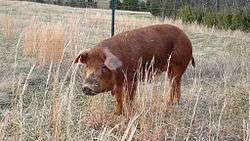Wattle (anatomy)

A wattle is a fleshy caruncle hanging from various parts of the head or neck in several groups of birds and mammals. A caruncle is defined as 'A small, fleshy excrescence that is a normal part of an animal's anatomy'. Within this definition, caruncles in birds include wattles, dewlaps, snoods and earlobes. Wattles are generally paired structures but may occur as a single structure when it is sometimes known as a dewlap. Wattles are frequently organs of sexual dimorphism. In some birds, caruncles are erectile tissue and may or may not have a feather covering.[1][2]
Wattles are often such a striking morphological characteristic of animals that it features in their common name. For example, the southern and northern cassowary are known as the double-wattled and single-wattled cassowary respectively, and there is a breed of domestic pig known as the red wattle.
Birds
Function
In birds, wattles are often an ornament for courting potential mates. Large wattles are correlated with high testosterone levels, good nutrition and the ability to evade predators, which in turn indicates a potentially successful mate. It has also been proposed that ornamental organs such as wattles are associated with genes coding for disease resistance.[3]
Examples
Birds with wattles include:
- From the neck or throat
- Birds of the family Casuarius: the northern, southern, and dwarf cassowaries
- Galliformes (e.g., wild turkeys,[4] chickens)
- Some vultures
- Some lapwings
- The male of the wattled starling
- Some[5] Australian wattlebirds (Anthochaera spp.)
- The New Zealand wattlebirds (Callaeidae), which include the kokako, tieke or saddleback, and the huia
- The wattled crane (Bugeranus carunculatus)
- From below or around the eyes
- The African wattle-eye or puffback flycatcher
- The wattled jacana (Jacana jacana)
- The African wattled lapwing (Vanellus senegallus)
- Many male pheasants
- Spectacled tyrant
Mammals
Mammals with wattles include:
- Many domestic goats, as a fleshy protuberance hanging either side of the throat
- Some domestic pigs, such as the kunekune, Lithuanian Native pig and the Red Wattle pig, as a fleshy protuberance hanging either side of the throat
Gallery
-

A common pheasant (Phasianus colchicus) with bright red facial wattles
-

A southern cassowary with double wattles hanging from the throat
-

A goat with wattles at the base of the throat
-

Red wattle pig with wattles at the base of the throat
See also
| Look up wattle in Wiktionary, the free dictionary. |
- Comb (anatomy) - the fleshy structure present atop the heads of many Galliform species
- Frontal shield
- Dubbing (poultry) - wattle amputation
References
- ↑ John James Audubon, Dean Amadon, John L Bull. 1967 The Birds of America
- ↑ Richard Bowdler Sharpe. 1888. Catalogue of the Birds in the British Museum, British Natural History Museum, Department of Zoology
- ↑ "Are large wattles related to particular MHC genotypes in the male pheasant?" Mariella Baratti, Martina Ammannati, Claudia Magnelli, Alessandro Massolo and Francesco Dessì-Fulgheri
- ↑ Hogan, C. Michael "Wild Turkey: Meleagris gallopavo", GlobalTwitcher.com, ed. N. Stromberg 2008
- ↑ John White. 1790. Voyage to New South Wales